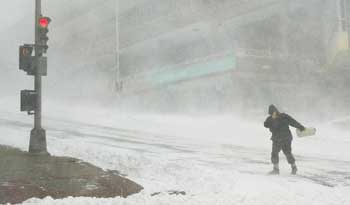So, I am writing this from a hotel in Fredericton. I was supposed to be home today…
We left Ontario yesterday, and we don’t really need to be back until tomorrow (I return to work Wednesday), but we had high hopes for doing the whole trip in two days–in the pre-Sarah days we would normally do a 12-hour leg the first day and a 7-hour leg the second day. We made sure we had 3 days this time, just in case Sarah wasn’t into long drives.
Well, the roads were pretty terrible yesterday, but I am a fairly decent driver in snow & ice, so we got to our normal stopping point in 14 hours. Sarah was amazing. She basically slept the whole way, just waking up to eat when I had to get gas, or to charm the other customers in restaurants when we stopped to eat. (I think I nearly lost her to the wait staff at a St. Hubert’s just east of Montreal–where Sarah proved she could be just as cute in French.)
So we got up this morning, and started out on out “short” leg. The roads were excellent. When we mentioned to the waitress at lunch that we were headed back to Halifax she basically laughed at us…
Blizzard pounds Maritimes
Photo: Andrew Vaughan/CP
A pedestrian struggles across a downtown street in Halifax Monday.
Canadian Press
Halifax— Winter arrived with a windy fury Monday in Atlantic Canada, leaving residents to dig out from a thick blanket of wet snow that clogged roads and disrupted holiday travel.
Wicked northeasterly winds, gusting up to 100 kilometres an hour caused white-outs, trapped people in their homes, and shut down shopping centres on the first day many stores were able to open after the Christmas holiday.
The storm was a sudden shift in the region’s weather.
Mild temperatures and trace amounts of snow marked December for the majority of Nova Scotia, P.E.I. and parts of southern New Brunswick.
But on Monday, Atlantic Canadians woke to find blizzard depositing between 20 and 40 centimetres of snow, and winds piling up metre-high snow banks.
The gusts made roads hazardous and created nasty wind chill factors for the few brave pedestrians.
“We’re looking at bitterly cold wind chills … between -25 to -30 degrees,” said Mike Campbell, a meteorologist with Environment Canada.
Environment Canada also issued an afternoon warning for a storm surge that was expected to cause sea levels to rise about 1.5 metres higher than normal during high tide along the Gulf of St. Lawrence.
Minor flooding was predicted for areas along the north shores of P.E.I., New Brunswick and Nova Scotia.
Power outages were scattered through rural areas, and repairs were difficult due to the powerful winds.
In the Nova Scotia community of Lockeport, 81-year-old Victor Williams lost power to his home when a falling tree snapped power lines running along his driveway. Reached by telephone, he said he and his wife were trying to keep warm by wearing three layers of clothing.
By early afternoon, a team from Nova Scotia Power was able to reach his home, and were expected to restore power by nightfall.
The storm kept most shoppers at home in metro Halifax and Moncton, although some malls managed to open for part of the day.
“The sales will be still on tomorrow,” said the owner of one Halifax gift store as she closed the doors on what should have been one of the busiest shopping days of the year. Legislation prevents wide-open Sunday openings for most retailers in Nova Scotia and P.E.I.
The driving nor’easter closed the Confederation Bridge between New Brunswick and Prince Edward Island to large trucks, and Marine Atlantic reported delays in ferry travel between Cape Breton and Newfoundland.
Most Air Canada, Jazz and Continental flights out of Halifax International Airport were cancelled throughout Monday while the Charlottetown airport closed by mid-afternoon.
The storm originated off the coast of New England where it spread sleet, freezing rain and more than a foot of snow along the Eastern Seaboard.
The western half of Newfoundland was expecting blizzard conditions in the afternoon, but as the storm moved east to St. John’s the snow was expected to change to rain and freezing rain.
Forecasters predicted the wind and snowfall would peak by the evening and then decrease to flurries by nightfall.
Anyway, we found out before we drove into the worst of it, and stopped here for the night. Apparently even had we tried to continue on we wouldn’t have been able to get home as the only road connecting NB to NS (the “Cobequid pass”) was completely closed.
The storm should be past tomorrow, so with any luck we’ll get home at a decent hour tomorrow.


